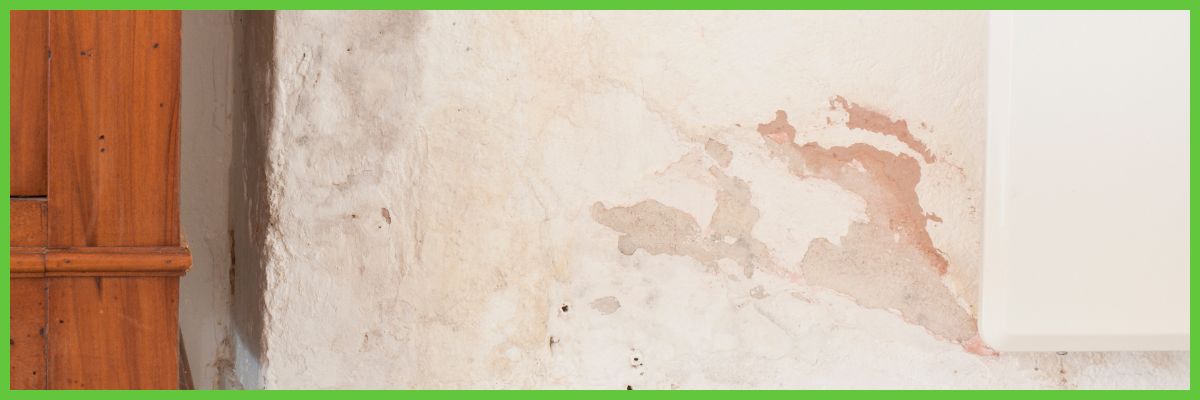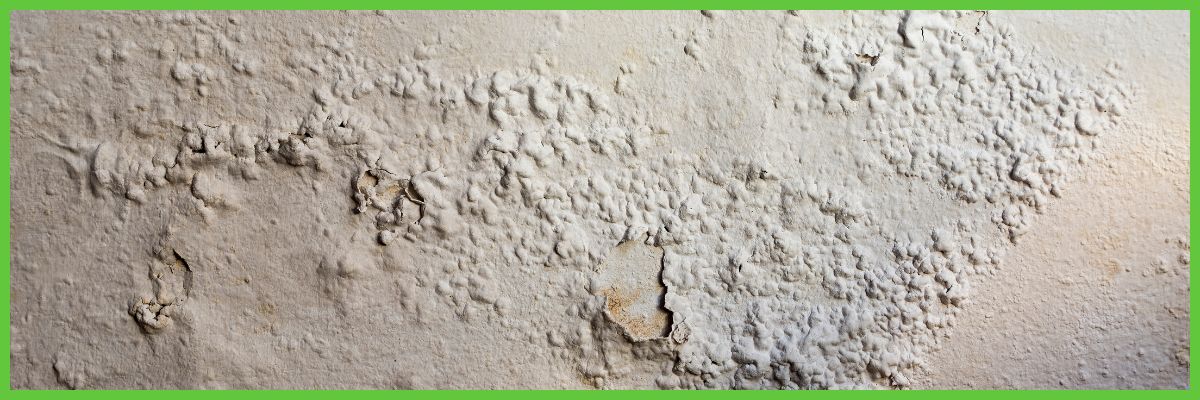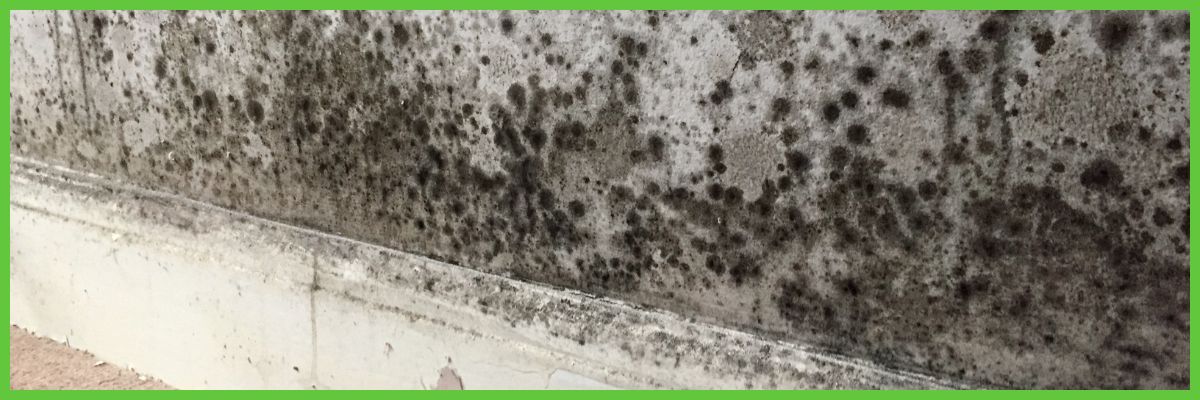Damp & Condensation
The three most common kinds of damp are rising damp, penetrating damp and surface damp, more commonly known as condensation. To work out the best way to treat the damp in your home, you’ll need to work out which of these you have (Rising damp, damp penetration or condensation). Below is a guide to understand which type of damp is present in your home and the cause of the increased moisture levels.
Rising Damp
 Rising damp is caused by ground water moving up through a wall. This is usually prevented from causing damage by a barrier called a damp-proof course. This can be seen as a horizontal plastic black strip at low level on the outside wall (typically visible on properties built from 1960 onwards). Older properties (without the black strip) have a damp proof course but are prone to a breakdown over time.
Rising damp is caused by ground water moving up through a wall. This is usually prevented from causing damage by a barrier called a damp-proof course. This can be seen as a horizontal plastic black strip at low level on the outside wall (typically visible on properties built from 1960 onwards). Older properties (without the black strip) have a damp proof course but are prone to a breakdown over time.
Penetrating Damp
 Penetrating damp is caused by water leaking through walls and/or ceilings. This type of damp can be seen in various areas of a property in most cases at high level. Penetrating damp is usually caused by structural problems in a building, such as faulty guttering or roofing. Or can be the result of leaking pipework.
Penetrating damp is caused by water leaking through walls and/or ceilings. This type of damp can be seen in various areas of a property in most cases at high level. Penetrating damp is usually caused by structural problems in a building, such as faulty guttering or roofing. Or can be the result of leaking pipework.
Penetrating damp often shows up through damp patches on walls, ceilings or floors, which may darken when it rains or when taps are run.
Condensation
 There is always moisture in the air, even if you can’t see it. Condensation is the most common kind of damp and is caused by moist air condensing on walls. It’s mainly a winter problem, as at this time of year walls are much colder than the air inside. When the air gets colder, it cannot hold the moisture which then condenses on cold surfaces such as windows, doors and even walls.
There is always moisture in the air, even if you can’t see it. Condensation is the most common kind of damp and is caused by moist air condensing on walls. It’s mainly a winter problem, as at this time of year walls are much colder than the air inside. When the air gets colder, it cannot hold the moisture which then condenses on cold surfaces such as windows, doors and even walls.
Condensation can be made worse by poor ventilation, and heating that comes on and off, as this allows warm, damp air to condense.
You may notice water droplets on windows or walls, see dark mould appearing and/or notice an unpleasant smell.
What is condensation?
There is always moisture in the air, even if you can’t see it. When the air gets colder, it cannot hold the moisture which then condenses on cold surfaces such as windows, doors and even walls.
What causes condensation?
- Too much moisture being produced in your home
- Not enough ventilation
- Cold surfaces
- The temperature of your home
How to reduce condensation?
- Ventilate your home all year round by opening windows, even only slightly and making sure any extractor fans are used.
- If there is moisture on your windows in the mornings wipe this off with kitchen roll or similar.
- Use heating correctly. It is better to keep your heating on low during the cooler periods as this improves air circulation, reducing condensation.
- Reduce the amount of moisture produced.
- Use crystal moisture traps, which can be bought cheaply and locally
Quick tips
- Don’t dry clothes on radiators
- Keep lids on pans when cooking
- When bathing, run the cold tap first
- Make sure tumble driers are properly ventilated
- When cooking or bathing, keep kitchen and bathroom doors closed
Black mould
What is black mould?
Black mould is a spore which grows in areas where there is excessive moisture, high humidity and lack of ventilation. It leaves a damp and musty smell and if untreated, can be harmful to people’s health.
Where can it be found?
It can usually be found in corners of rooms, behind furniture and around windows and doors. It may also be present inside wardrobes on clothes. Bathrooms and kitchens may show evidence of black mould on tiles and taps.
Preventing and treating black mould
Black mould needs moisture to grow. It is important to reduce the moisture produced and ventilate your home well.
- Remove any moisture on doors, windows and sills each morning to prevent mould growth and treat with an anti mould solution which can be bought cheaply and locally.
- Avoid putting furniture and wardrobes against walls as this prevents air circulation.
- Wipe off any signs of black mould with an anti mould solution to prevent growth. Note, bleach will not kill off the spores completely and will allow for regrowth
Removing mould
When dealing with mould, safety should always be a top priority, spreading the mould around your home can make the problem worse. By following these steps, you can effectively remove mould from your home while keeping yourself and your family safe.
To ensure your safety, always follow the instructions from the products label as these may vary.
There are a few important steps you should take before beginning the mould removal process:
- Always use biocides safely and read the label and product information before use.
- First test on an inconspicuous area.
- We recommend wearing rubber/plastic gloves
- It’s a good idea to cover the floor under the area you are cleaning to catch any falling mould, which can then be disposed of immediately.
- Proper ventilation in the room is also key when removing mould. To allow mould spores to escape, make sure to open a window or external door. This will help prevent the mould from spreading to other parts of your home.
- When it comes to cleaning products, it is best to use a mould remover spray, additional sprays can be easily found online or at hardware shops or supermarkets. Follow the instructions on the mould cleaning product as each product will vary.
- Once you have your cleaner, apply it to the affected area and leave the product to work . A disposable cloth or tissue can be used to wipe any remaining residue.
- Once you have finished cleaning, be sure to allow the area to dry completely before closing the window.
Take a look at our helpful videos below to prevent condensation in your home.
Read our guide on condensation here.
For advice on mould or condensation in your home please get in touch as soon as possible.
















